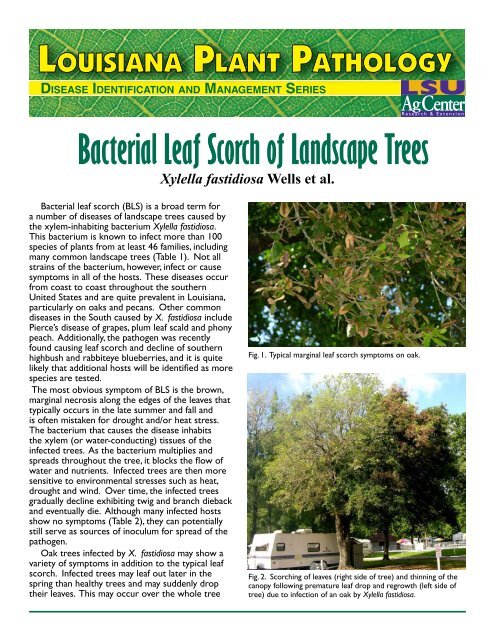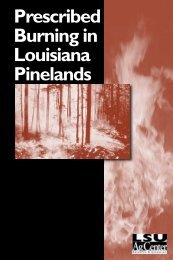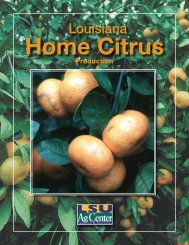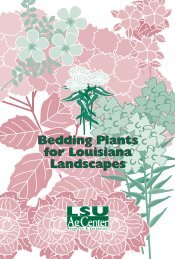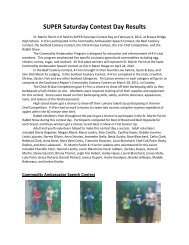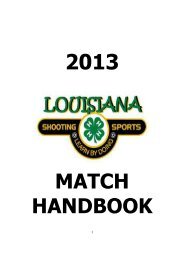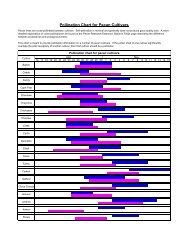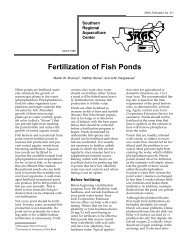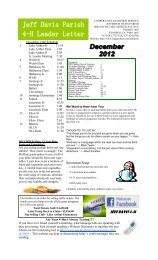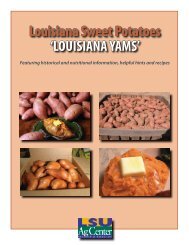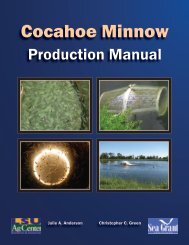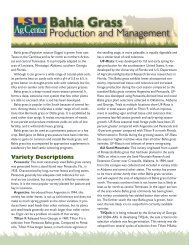Bacterial Leaf Scorch of Landscape Trees - The LSU AgCenter
Bacterial Leaf Scorch of Landscape Trees - The LSU AgCenter
Bacterial Leaf Scorch of Landscape Trees - The LSU AgCenter
You also want an ePaper? Increase the reach of your titles
YUMPU automatically turns print PDFs into web optimized ePapers that Google loves.
<strong>Bacterial</strong> <strong>Leaf</strong> <strong>Scorch</strong> <strong>of</strong> <strong>Landscape</strong> <strong>Trees</strong><br />
Xylella fastidiosa Wells et al.<br />
<strong>Bacterial</strong> leaf scorch (BLS) is a broad term for<br />
a number <strong>of</strong> diseases <strong>of</strong> landscape trees caused by<br />
the xylem-inhabiting bacterium Xylella fastidiosa.<br />
This bacterium is known to infect more than 100<br />
species <strong>of</strong> plants from at least 46 families, including<br />
many common landscape trees (Table 1). Not all<br />
strains <strong>of</strong> the bacterium, however, infect or cause<br />
symptoms in all <strong>of</strong> the hosts. <strong>The</strong>se diseases occur<br />
from coast to coast throughout the southern<br />
United States and are quite prevalent in Louisiana,<br />
particularly on oaks and pecans. Other common<br />
diseases in the South caused by X. fastidiosa include<br />
Pierce’s disease <strong>of</strong> grapes, plum leaf scald and phony<br />
peach. Additionally, the pathogen was recently<br />
found causing leaf scorch and decline <strong>of</strong> southern<br />
highbush and rabbiteye blueberries, and it is quite<br />
likely that additional hosts will be identified as more<br />
species are tested.<br />
<strong>The</strong> most obvious symptom <strong>of</strong> BLS is the brown,<br />
marginal necrosis along the edges <strong>of</strong> the leaves that<br />
typically occurs in the late summer and fall and<br />
is <strong>of</strong>ten mistaken for drought and/or heat stress.<br />
<strong>The</strong> bacterium that causes the disease inhabits<br />
the xylem (or water-conducting) tissues <strong>of</strong> the<br />
infected trees. As the bacterium multiplies and<br />
spreads throughout the tree, it blocks the flow <strong>of</strong><br />
water and nutrients. Infected trees are then more<br />
sensitive to environmental stresses such as heat,<br />
drought and wind. Over time, the infected trees<br />
gradually decline exhibiting twig and branch dieback<br />
and eventually die. Although many infected hosts<br />
show no symptoms (Table 2), they can potentially<br />
still serve as sources <strong>of</strong> inoculum for spread <strong>of</strong> the<br />
pathogen.<br />
Oak trees infected by X. fastidiosa may show a<br />
variety <strong>of</strong> symptoms in addition to the typical leaf<br />
scorch. Infected trees may leaf out later in the<br />
spring than healthy trees and may suddenly drop<br />
their leaves. This may occur over the whole tree<br />
Fig. 1. Typical marginal leaf scorch symptoms on oak.<br />
Fig. 2. <strong>Scorch</strong>ing <strong>of</strong> leaves (right side <strong>of</strong> tree) and thinning <strong>of</strong> the<br />
canopy following premature leaf drop and regrowth (left side <strong>of</strong><br />
tree) due to infection <strong>of</strong> an oak by Xylella fastidiosa.
or be limited to individual branches or sectors <strong>of</strong><br />
the tree. <strong>The</strong>se trees will then leaf out again, but<br />
the foliage may remain relatively sparse compared<br />
to healthy trees. Occasionally, large branches scattered<br />
throughout the canopy may die suddenly as<br />
well.<br />
<strong>The</strong> bacterium is spread primarily by sharpshooter<br />
leafhoppers and other xylem-feeding<br />
Table 1. <strong>Landscape</strong> trees susceptible to<br />
Xylella fastidiosa<br />
Common name Scientific name<br />
Crape myrtle Lagerstroemia indica<br />
Dogwood Cornus florida<br />
Elm Ulmus spp.<br />
Hackberry Celtis occidentalis<br />
Jacaranda Jacaranda mimosifolia<br />
Magnolia Magnolia grandiflora<br />
Maidenhair tree Ginko biloba<br />
Maple Acer spp.<br />
Oak Quercus spp.<br />
Peach Prunus persica<br />
Pecan Carya illinoinensis<br />
Plum Prunus domestica<br />
Purple-leaf plum Prunus cerasifera<br />
Sweetgum Liquidambar styraciflua<br />
Sycamore Platanus occidentalis<br />
White mulberry Morus alba<br />
Author & Photo Credits<br />
Don Ferrin, Ph.D.<br />
Extension Plant Pathologist<br />
Department <strong>of</strong> Plant Pathology<br />
and Crop Physiology<br />
Visit our Web site: www.lsuagcenter.com<br />
insects such as spittlebugs. Once a tree is infected,<br />
there is no cure. <strong>The</strong> use <strong>of</strong> cultural practices that<br />
reduce environmental stresses, particularly water<br />
stress, may help prolong the life <strong>of</strong> infected trees.<br />
Management <strong>of</strong> these diseases relies on the removal<br />
<strong>of</strong> declining trees and replanting with species that<br />
are not known to be susceptible to the disease.<br />
Table 2. Some symptomless hosts <strong>of</strong><br />
Xylella fastidiosa<br />
Common name Scientific name<br />
American beautyberry Callicarpa americana<br />
American elder Sambucus canadensis<br />
Bermuda grass Cynodon dactylon<br />
Blackberry Rubus procerus<br />
Boston ivy Parthenocissus tricuspidata<br />
Dallis grass Paspalum dilatatum<br />
English ivy Hedera helix<br />
Goldenrod Solidago fistulosa<br />
Johnson grass Sorghum halapense<br />
Peppervine Ampelopsis arborea<br />
Periwinkle Vinca minor<br />
Sumac Rhus sp.<br />
Virginia creeper Parthenocissus quinquefolia<br />
White clover Trifolium repens<br />
Wild grape Vitis sp.<br />
Wild strawberry Fragaria sp.<br />
Yellow buckeye Aesculus x hybrid<br />
Louisiana State University Agricultural Center<br />
William B. Richardson, Chancellor<br />
Louisiana Agricultural Experiment Station<br />
David J. Boethel, Vice Chancellor and Director<br />
Louisiana Cooperative Extension Service<br />
Paul D. Coreil, Vice Chancellor and Director<br />
Pub. 3132 (online only) 08/09<br />
Issued in furtherance <strong>of</strong> Cooperative Extension work, Acts <strong>of</strong> Congress <strong>of</strong> May 8 and June<br />
30, 1914, in cooperation with the United States Department <strong>of</strong> Agriculture. <strong>The</strong> Louisiana<br />
Cooperative Extension Service provides equal opportunities in programs and employment.


